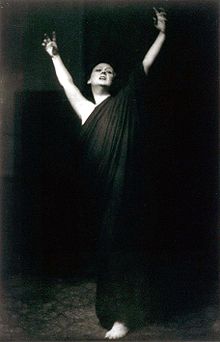- Modern dance in the United States
-
Culture of the
United StatesMain articles: Dance in the United States and Modern danceClosely related to the development of American music in the early 20th century was the emergence of a new, and distinctively American, art form -- modern dance. Among the early innovators was Isadora Duncan (1878–1927), who stressed pure, unstructured movement in lieu of the positions of classical ballet. Duncan said "from early childhood I have considered the freedom of my body essential to rhythm of movement"[1]. Her emphasis on the natural world and body in the context of concert dance influenced the ideals of the modern dancers who succeed her in America.
The main line of development, however, runs from the dance company of Ruth St. Denis (1878–1968) and her husband-partner, Ted Shawn (1891–1972), which produced work exploring images from other countries that were considered exotic by American audiences[2]. St. Denis' pupil Doris Humphrey (1895–1958) looked outward for inspiration, to society and human conflict. Another pupil of St. Denis, Martha Graham (1893–1991), whose New York-based company became perhaps the best known in modern dance, sought to express an inward-based passion. Many of Graham's most popular works were produced in collaboration with leading American composers -- "Appalachian Spring" with Aaron Copland, for example.
A significant contributing factor to the development and spread of Modern Dance in the United States in the 20th century was the establishment of Bennington College's Summer School of Dance. The program was established in 1934 and led by dancer/educator Martha Hill[3]. Students attended classes in dance techniques, dance composition, music for dance, teaching methods, production, dance history and critical theory[4]. The school's faculty included established dancers and choreographers such as Martha Graham, Hanya Holm, Charles Weidman and Doris Humphrey[5], many of whom had received their training from European Modern and Expressionist dancers. The Bennington School let American Modern dancers assemble to develop a dance genre of their own identity, while at the same time established a model for University-level education programs in dance in the United States[6]. With clear pioneers, pupils and principles, Modern Dance began to emerge as a distinctly American art form to be taught and developed throughout the country and continent.
Later choreographers searched for new methods of dance composition. Merce Cunningham (1919–2009) introduced chance procedures and composition by field. Alvin Ailey (1931–1989) incorporated African dance elements and black music into his works. Recently such choreographers as Mark Morris (1956- ) and Liz Lerman (1947-) have defied the convention that dancers must be thin and young. Their belief, put into action in their hiring practices and performances, is that graceful, exciting movement is not restricted by age or body type.
African American modern dance
See also: African American danceAfrican American contributions to modern dance were substantial, they included pure modern dance works or blended modern dance with African American vernacular dance, African dance and Caribbean influences.
- Katherine Dunham - African-American dancer, and anthropologist, originally a ballet dancer she founded her first company Ballet Negre in 1936 and later the Katherine Dunham Dance Company based in Chicago, Illinois. Dunham opened a school in New York (1945) where she taught Katherine Dunham Technique, a blend of African and Caribbean movement (flexible torso and spine, articulated pelvis and isolation of the limbs and polyrhythmic movement) integrated with techniques of ballet and modern dance.
- Pearl Primus - a dancer, choreographer and anthropologist Primus drew on African and Caribbean dances to create strong dramatic works characterized by large leaps in the air. Primus often based her dances on the work of black writers and on racial and African-American issues. Primus created works based on Langston Hughes The Negro Speaks of Rivers (1944), and Lewis Allan's Strange Fruit (1945). Her dance company developed into the Pearl Primus Dance Language Institute which teaches her method of blending African-American, Caribbean, and African influences with modern dance and ballet techniques.
- Alvin Ailey- a student of Lester Horton (and later Martha Graham) Ailey spent several years working in both concert and theatre dance. in 1930 Ailey and a group of young African-American dancers perform as Alvin Ailey American Dance Theater in New York. Ailey drew upon his blood memories of Texas, the blues, spirituals and gospel as inspiration, his most popular and critically acclaimed work is Revelations (1960).
Notes
- ^ "The California Girl Who Made Athens Gasp Wearing Classic Grecian Costumes in the Streets and to the Theatres," San Francisco Chronicle, November 22. 1903, 8.
- ^ Desmond, Jane. "Dancing out the difference: Cultural Imperialism and Ruth St. Denis's Radha of 1906" Moving History/Dancing cultures(2001): 256-267.
- ^ Soares, Janet Mansfield. "Grassroots Modern" Humanities Vol. 31 issue 5. (2010): 38-42. 1 Feb. 2011 <http://web.ebscohost.com/ehost/detail?hid=10&sid=301696b9-2813-436f-b25c-013936fd45a5%40sessionmgr15&vid=7&bdata=JnNpdGU9ZWhvc3QtbGl2ZQ%3d%3d#db=a9h&AN=53920027>.
- ^ Soares, Janet Mansfield. "Grassroots Modern" Humanities Vol. 31 issue 5. (2010): 38-42. 1 Feb. 2011 <http://web.ebscohost.com/ehost/detail?hid=10&sid=301696b9-2813-436f-b25c-013936fd45a5%40sessionmgr15&vid=7&bdata=JnNpdGU9ZWhvc3QtbGl2ZQ%3d%3d#db=a9h&AN=53920027>.
- ^ Soares, Janet Mansfield. "Grassroots Modern" Humanities Vol. 31 issue 5. (2010): 38-42. 1 Feb. 2011 <http://web.ebscohost.com/ehost/detail?hid=10&sid=301696b9-2813-436f-b25c-013936fd45a5%40sessionmgr15&vid=7&bdata=JnNpdGU9ZWhvc3QtbGl2ZQ%3d%3d#db=a9h&AN=53920027>.
- ^ GRASSROOTS MODERN. By: Soares, Janet Mansfield, Humanities, 00187526, Sep/Oct2010, Vol. 31, Issue 5
See also
- Culture of New York City
- Dance
- Country Dance
- Disco
- Square Dance
- Swing
- Jazz
- Tap
- Break dancing
- Modern dance
- Dance music
Categories:
Wikimedia Foundation. 2010.

